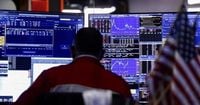On October 17, 2025, the U.S. stock market opened to a landscape marked by uncertainty and volatility, as concerns over regional banks’ credit quality rippled through Wall Street and beyond. The S&P 500 dipped by 0.3%, the Dow Jones eked out a 0.1% gain, and the Nasdaq Composite slid by 0.5%. This mixed opening reflected a market grappling with fresh anxieties about bad loans, alleged fraud, and the aftershocks of recent bank disclosures, according to Reuters and Barchart.
At the heart of this week’s turbulence were Zions Bancorporation and Western Alliance Bancorp, two regional banks that became the epicenter of investor nervousness. Zions revealed losses linked to two commercial and industrial loans, while Western Alliance disclosed it had initiated legal action alleging fraud by Cantor Group V, LLC—a claim that Cantor has denied. The revelations triggered a sharp selloff: Zions shares plummeted more than 13% and Western Alliance fell over 10% on October 16, as reported by Reuters. The KBW Nasdaq Regional Banking Index nosedived 6.3% that day, underscoring the depth of investor unease.
“Markets have been gripped by a sense of fear and panic in the last couple of days,” Timothy Coffey, associate director of depository research at Janney Montgomery Scott, told Reuters. “There are different issues that are being conflated into one big issue about credit concerns.” Coffey added that the pressure on bank stocks was likely to persist, likening the panic to a fever that takes time to subside.
The recent disclosures didn’t occur in isolation. The banking sector is still haunted by memories of the 2023 crisis, when Silicon Valley Bank’s collapse sent shockwaves through the financial system. This week’s news rekindled those memories, especially as the sector faced additional exposure to U.S. auto bankruptcies at First Brands and Tricolor. These events have prompted regulators to keep a close eye on banks’ commercial real estate exposure, uninsured deposit levels, and overall deposit strategies—a vigilance that, according to Nutter attorney Dan Hartman in Reuters, has not waned since 2023.
Yet, not everyone sees a repeat of the past. Fifth Third CEO Tim Spence was quick to draw a distinction: “I would not equate what happened this week to the 2023 banking crisis.” Spence suggested that investors were reacting to losses they didn’t fully understand, but he expected shares would recover as more information emerged. This sentiment was echoed in the market’s behavior the following day. On October 17, U.S. bank stocks staged a modest rebound, clawing back some of their steep losses. Zions rose 5.8%, Western Alliance gained 3.1%, and the KBW Regional Banking Index ended the day up 1.7% after its previous plunge, according to Reuters.
Other regional banks weren’t spared from the week’s volatility. Citizens Financial Group, Regions Financial, KeyCorp, Truist Financial, and Huntington Bancshares all saw their shares drop by more than 5% on October 16, as reported by Barchart. The broader market mood was further soured by disclosures of loan charge-offs and fraud at several institutions, fueling a sense of contagion risk that spilled into European and Asian markets.
Amidst the banking jitters, there were pockets of resilience. Technology and AI infrastructure stocks bucked the downward trend, lifted by Taiwan Semiconductor Manufacturing Co.’s second upward revision of its 2025 revenue growth projections this year. This optimism in the tech sector, particularly around AI spending, provided a counterweight to the gloom enveloping financials. Shares of Micron Technology and ON Semiconductor both climbed more than 5%, while Nvidia, Analog Devices, and others posted healthy gains, as noted by Barchart.
Meanwhile, the bond market responded to the week’s uncertainty with a rally in U.S. Treasuries. The 10-year note yield dropped to a 6.25-month low of 3.97% on October 16, buoyed by dovish comments from Federal Reserve officials. Fed Governor Christopher Waller stated that the central bank could continue to lower interest rates in quarter-point increments to support a faltering labor market. Richmond Fed President Tom Barkin added that U.S. productivity growth appeared to be improving “significantly,” potentially offsetting inflationary pressures from trade tariffs. These reassurances helped steady nerves, at least temporarily, and supported equities even as regional banks faltered.
Complicating matters further, the ongoing U.S. government shutdown cast a shadow over the financial landscape. The shutdown delayed key economic reports, including weekly unemployment claims and the September payroll report, muddying the waters for investors seeking clarity. According to Barchart, the White House warned that a prolonged shutdown could lead to widespread federal employee furloughs, potentially pushing the unemployment rate up to 4.7%. Bloomberg Economics estimated that 640,000 federal workers could be affected if the impasse drags on.
Despite these headwinds, the broader earnings season offered glimmers of hope. According to Bloomberg Intelligence, 78% of S&P 500 companies that had reported so far beat analysts’ forecasts. However, the Q3 profit increase was projected to be just 7.2% year-over-year—the smallest in two years—and sales growth was expected to slow to 5.9% from 6.4% in Q2. Investors, it seemed, were willing to look through the immediate risks in hopes that the consumer would “muddle through,” as Rob Haworth, senior investment strategist at U.S. Bank Wealth Management, told Reuters.
Still, the mood was anything but complacent. The market’s defensive posture was evident in options trading, where hedging against credit deterioration and broader contagion picked up, though Chris Murphy of Susquehanna Financial Group cautioned it wasn’t yet “a full-blown systemic panic.” The specter of further credit market strains loomed large, especially given JPMorgan Chase CEO Jamie Dimon’s warning: “When you see one cockroach, there are probably more, and so everyone should be forewarned.”
White House economic adviser Kevin Hassett tried to reassure the public, telling Fox Business Network that banks had ample reserves and that officials were “cleaning things up right now.” Stephen Biggar, director of financial research at Argus Research, also downplayed the risk of contagion, noting that recent bankruptcies appeared isolated and that bank earnings reports actually showed improving credit quality in the third quarter.
As the week drew to a close, U.S. markets remained a study in contrasts—nervous but not panicked, battered but not broken. The major indexes ended Friday’s choppy session higher, helped by the rebound in bank stocks and the ongoing strength in tech. Overseas, European and Asian markets followed suit, with the Euro Stoxx 50 and Japan’s Nikkei both posting gains.
With the Federal Reserve widely expected to cut rates by 25 basis points at its October 28–29 meeting, and with Q3 earnings season in full swing, all eyes are on whether the market’s resilience can outlast its fears. For now, investors are left to navigate a landscape full of both risk and opportunity—one where, as recent days have shown, sentiment can turn on a dime.




